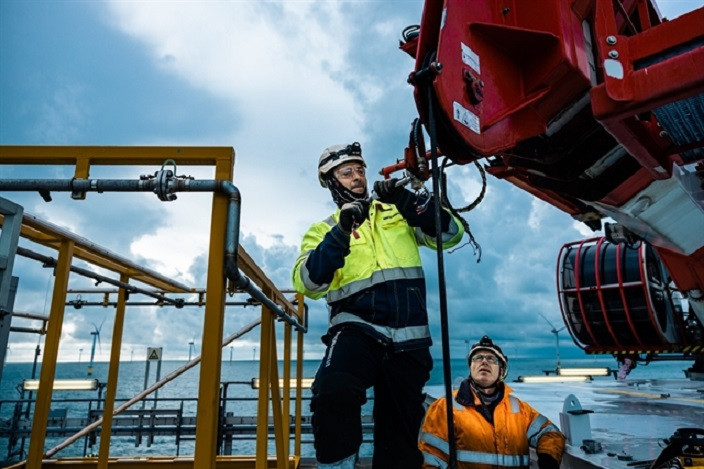
That’s the opinion shared by many experts at a workshop on Thursday titled "Career Opportunities in the Offshore Wind Industry" hosted by the Copenhagen Infrastructure Partners (CIP), one of the world's largest offshore wind developers from Denmark, and the School of Electrical and Electronic Engineering under Hà Nội University of Science and Technology.
With reference to the Power Development Plan VIII (PDP8), which was approved on 15th May 2023, Việt Nam plans to increase the capacity of offshore wind from zero at the present to 6GW by 2030 and a vision of 70 - 91.5 GW by 2050 to contribute to net zero targets established at COP26.
To achieve this goal, developers and contractors need to have an available and appropriately skilled workforce for each phase of renewable energy projects, and with offshore wind, the scale and variety of this workforce has huge potential.
Stuart Livesey, who presented at the workshop, said: “CIP will need a qualified workforce for our portfolio of future projects. La Gàn as an example if built out to its full 3.5GW capacity, will require over 45,000 FTE employees throughout its lifetime (FTE = 1 full time employee for a year). CIP seeks to support Việt Nam and its people in benefiting from the employment aspects of the high-tech offshore wind industry, and also to allow Việt Nam to become a major renewable energy export hub for the future to APAC and beyond.’’
Throughout the life cycle of an offshore wind farm (about 35-45 years), a number of positions are needed in all three main phases including Development, Construction & Operation, while some other positions will only be involved for one or two phases of the project. The Construction phase has the highest demand for human resources (accounting for 49 per cent of total jobs created throughout the project life cycle), followed by the Operations & Maintenance phase (35 per cent), the Development phase (10 per cent), and the Decommissioning phase (6 per cent).
Among these positions, some are completely new and have never existed in Việt Nam yet, such as the positions in charge of analysing wind output, manufacturing monopile foundations, installing offshore wind turbines, maintaining offshore turbine blades, and operating & maintaining offshore wind turbines.
While offshore wind is a completely new industry in Việt Nam, many roles within this industry can be undertaken by people from other industries who can transition relatively easily, such as oil and gas exploration and production, nearshore and onshore wind projects, and onshore construction, which share similar engineering, safety, and working practices. However, this experience is by no means a must.
Key training
There are many different certifications or other training requirements that may be needed to work on offshore wind projects.
Currently in Việt Nam, some long-term programmes can already support offshore wind projects of the future, such as Coastal and Offshore Engineering, Oil & Gas, Construction Engineering, Logistics and Supply Chain Management, Maritime Navigation, Mechanical Engineering, Power Management, Ship Control, Ship Machinery, Renewable Energy, Geological engineering, and Environmental engineering. This training can be completed in several Vietnamese universities, including (but not exclusive to) University of Science and Technology, Electric Power University, University of Civil Engineering and Maritime University.
Alternatively, some short-term programs, including Basic Safety, Rescue Training, Enhanced First Aid, and Basic Technical Training, also provide necessary skills for some technical offshore wind jobs.
Supporting PDP8 goals
Offshore wind power projects bring many socio-economic benefits through job creation for Vietnamese people and the development of the local supply chain.
During the early stages of the industry, clear and encouraging policies will help investors have the necessary certainty to make long-term commitments and decide on billions of dollars in investments, while local contractors can proactively plan their production and recruitment activities and the universities can proactively update and adjust curriculum to better prepare graduates for the future workplace.
“It usually takes at least six years for an offshore wind project to move from survey licensing to commercial operation,” said Stuart. “Therefore, to achieve the target of 6GW of offshore wind power by 2030 which can contribute to realising Việt Nam’s net zero commitment by 2050, it is essential to issue the pilot mechanism for offshore wind development in 2024, and in the meantime, gradually complete the related policies and regulations. We are ready and committed to delivering this in Việt Nam, and the legacy of studies and preparation undertaken on the La Gan project means this is ideally placed to function as a pilot project under such a fast-track pilot mechanism. Our willingness to work transparently with state-owned enterprises and local developers, means CIP can contribute to sharing knowledge and skills with Việt Nam’s industry, and also learning directly more about the needs and nuances to deliver mega-scale power projects in Việt Nam."
At the same event, the publication titled "Offshore wind workforce" compiled by CIP was launched in both English and Vietnamese.
The guide provides an overview of the workforce demand throughout the Development, Construction, and Operation phases of an offshore wind farm, a list of typical jobs, and detailed job descriptions of over 70 different positions. It also shows the necessary skills and qualifications, and available training programmes in Việt Nam that can support entrance in this industry.
Founded in 2012, Copenhagen Infrastructure Partners (CIP) today is the world’s largest dedicated fund manager within greenfield renewable energy investments and a global leader in offshore wind. The funds managed by CIP focus on investments in offshore and onshore wind, solar PV, biomass and energy-from-waste, transmission and distribution, reserve capacity, storage, advanced bioenergy, and Power-to-X (batteries, ammonia, green hydrogen).
CIP manages 12 funds and has raised approximately US$30 billion for energy investments and has established a market-leading renewables pipeline of approximately 120GW of energy projects across technologies and geographies. Almost half of this renewable energy portfolio (over 60GW) constitutes offshore wind. — VNS